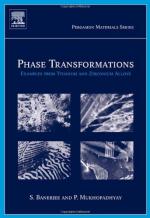|
This section contains 368 words (approx. 2 pages at 300 words per page) |
Zirconium is the second element in Group 4 of the periodic table, one of the transition metals. It has an atomic number of 40, an atomic mass of 91.22, and a chemical symbol of Zr.
Properties
Zirconium usually occurs as a hard, grayish white metal, whose surface has a flaky appearance. It may also be prepared as a black or bluish black powder. Zirconium's melting point is 3,375°F (1,857°C), its boiling point is 6,471°F (3,577°C), and its density is 6.5 grams per cubic centimeter. Zirconium is a fairly inactive element that combines slowly with oxygen in the air, but does not react with most cold acids or with water. One of its most important and useful properties is its transparency to neutrons. Most metals tend to absorb neutrons that pass through them, but zirconium is largely transparent to them.
Occurrence and Extraction
Zirconium is a relatively common element in the Earth's crust with an abundance estimated at about 150-230 parts per million. Its most common ores are zircon (zirconium silicate; ZrSiO4) and baddeleyite (zirconia or zirconium oxide; ZrO2). The largest suppliers of zirconium in the world are South Africa and Australia.
Discovery and Naming
Zirconium was discovered in 1789 by the German chemist Martin Heinrich Klaproth. Klaproth found the element in a stone brought to him from the island of Ceylon (now Sri Lanka). The stone was commonly known as a jacinth (or hyacinth) stone and had been known for many years. In fact, Saint John talks about the jacinth stone as one of the jewels found in the walls surrounding Jerusalem. Klaproth chose zirconium as a name for the new element from the Persian name for the same stone, zargun, meaning "gold-like."
Uses
A very small amount of zirconium is used in the manufacture of alloys for products such as flash bulbs, rayon spinnerets, lamp filaments, precision tools, and surgical instruments. About 95% of all the element produced, however, is converted to compounds, the two most important of which are zircon (zirconium silicate) and zirconia (zirconium oxide). Synthetic zircon is used to make gemstones that resemble fine diamonds and as a refractory material in foundry molds and furnace linings. Zircon and zirconium are both used extensively as abrasives in industrial operations.
|
This section contains 368 words (approx. 2 pages at 300 words per page) |


